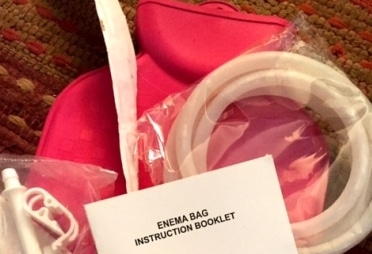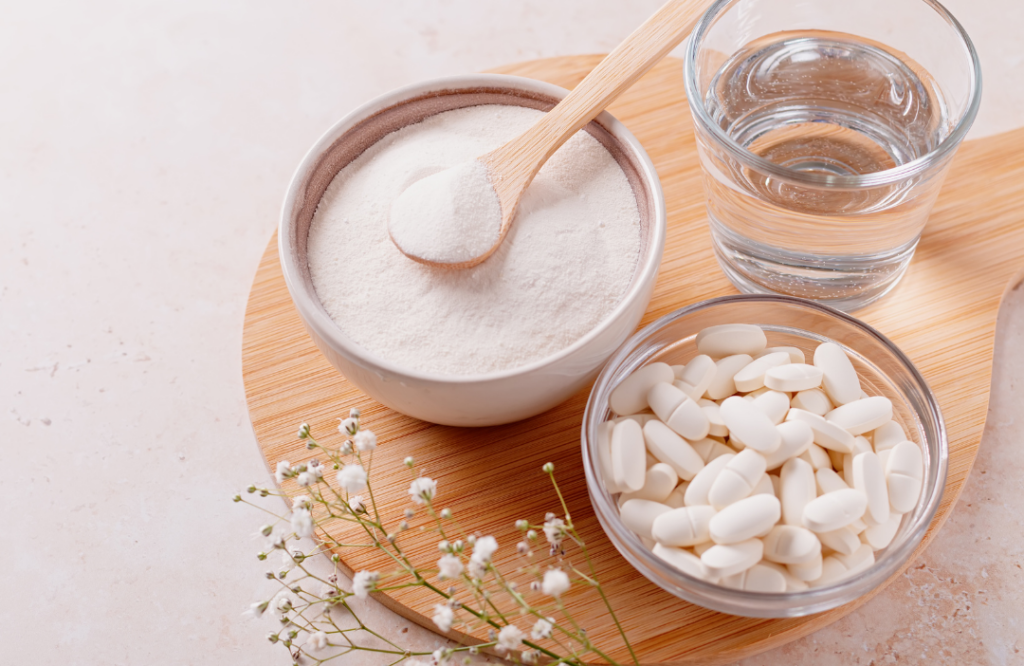Ultimate Guide To Safe & Healthy Enemas
Published on November 5, 2015 by Dr. Caitlin Gordon
A Guide to Why and How To
 I was scared to try an enema. I put off trying one for a full year. I mean literally it was on my “to do” list for a year and I kept being like ehhhh, not really in the mood for that today. Until I finally just did it. And now I wonder why I waited so long.
I was scared to try an enema. I put off trying one for a full year. I mean literally it was on my “to do” list for a year and I kept being like ehhhh, not really in the mood for that today. Until I finally just did it. And now I wonder why I waited so long.
As a culture, we are not very comfortable talking about poop; as women, even less so. I refused to talk about pooping with a man until the age of 24. I coyly pretended that I was a unicorn, and only rainbow dust came out of my bottom. Talking about poop is half habit–the more you do it the less awkward you feel, and half self-esteem. You have to trust that you’re still a beautiful, lovable, sexually desirable human… bodily functions and all. I started discussing going number # out of necessity. While in school studying Traditional Chinese Medicine, talking about poop, and every other bodily function, was part of the daily curriculum. I ask every patient who comes in to see me about their bathroom habits. It’s NBD (no big deal) anymore. If you don’t yet have my comfort level with this topic, no judgment here, but an enema might seem far too up close and personal. Wait until you’re ready, or think of it as a crash-course in poop positivity :) Poop has a lot of valuable information about your health, as it is one of the primary detox functions and a peek into your internal environment.
What is an enema?
An enema is a fluid injection into the lower bowel by way of the rectum intended to flush out the contents or administer a substance for absorption through the large intestine. An enema stimulates stool evacuation. In other words, you’re flushing out your colon.
Enemas are no fad. There is evidence that an Egyptian king dating back as far as 1500 B.C. received regular enemas from his personal physician. The ancient regions of India, Africa, Greece, and China all used enemas. American Indians performed enemas. They’ve been a longstanding tradition. As with most things that stand the test of time, despite modern medicine poo-pooing it (like that?!), enemas probably have some merit or they would have faded out with the leeches and the mercury tonics (and other healthcare techniques which proved dangerous or ineffective).
How do you DO it?
 First, you need an enema supply kit of some kind. I ordered mine off of amazon.com, this one to be precise. I would guess you could google other places to order one. Other Supplies:
First, you need an enema supply kit of some kind. I ordered mine off of amazon.com, this one to be precise. I would guess you could google other places to order one. Other Supplies:
- Old towel (or two)
- Lubricant (coconut oil works great)
- Warm Water
- Sea salt
- A sense of adventure
The saltwater is important as it helps maintain the proper balance of electrolytes in your colon. This is an intimidating process the first time, but after doing it you’ll realize how easy it is. You will want to warm up about 1 quart (or a teapot full) of water. I think salt water enemas are the easiest way to start. Add 1 TB pure sea salt and let it dissolve. The water should be warm but not hot.
- The best time of day is after you’ve had a morning bowel movement and before you’ve eaten anything else.
- Clean all your enema equipment with soap and water
- Lay your old towel down on the bathroom floor or in the bathtub
- Hang your enema bag from somewhere sturdy– door handle, showerhead, curtain rod, wherever.
- Check to make sure your enema hose is clamped close
- Fill your enema bag with your warm salt water
- Makes sure you have clean hands
- Lubricate the end of your enema hose (don’t get scared)
- Lay on your left side in a comfortable position and insert your enema hose into your rectum 3-6 inches or wherever feels most comfortable. You don’t want it to slide right out, which can happen once there is water flowing. This is the part that people get weird about, but the tube is far smaller than any poop you’ve ever pooped so don’t get your panties too twisted–it’s not uncomfortable if you just relax.
- Slowly release the clamp and allow some water to flow. Start slow. Breathe deeply. Continue this process until you feel you cannot hold any more water and then massage your abdomen or lay on your back with your legs up, or switch sides, or even walk around if you’re feeling like you have great sphincter control (ha!) for as long as feels comfortable. If it’s your first enema, you might only make it through a quarter of the water in your bag and need to evacuate. That’s fine! You can try the rest of the bag right away and may be able to hold more water for longer, or just wait until the next time you perform an enema. The idea is the longer you retain water, the more built up hard deposits along the inside of your colon will loosen and be flushed out. You’ll still get plenty of flushing action though if you can’t retain the water for more than a minute or two.
What are the benefits?
In a very immediate sense, enemas relieve constipation. They are super helpful for flushing out built-up waste for any reason. You may be having daily bowel movements but what you’re passing each day is food from two days before, so essentially you’ve got a lot backed up, despite things moving along at a regular rate. An enema can help clean out trapped waste. Enemas can help flush out parasites, bad bacteria, old food, relieve issues related to IBS, bloating, etc. They are especially useful if you are fasting, doing any type of liver detox, parasite cleanse, heavy metal cleanse, or are working to rebalance your gut flora as everything you kill off gets dumped into your large intestine. Frequent evacuation can be therapeutic in these instances.
There are reports of people experiencing increased energy, fewer headaches, clearer skin, more frequent bowel movements, better sleep, greater mental clarity, less sinus congestion and more from enemas.
Some doctors argue enemas don’t provide any true benefits, as your body is designed to rid itself of waste effectively, without any help. This is true… Just as true as the fact that we shouldn’t need to do any type of cleansing because our livers, kidneys, and skin are supposed to do that. This is all great in theory. However, so many factors contribute to dysfunctional digestion in this day and age that I think it’s fair to say we could use all the help we can get.
The proof is in the experience. You just feel better after an enema. There is no good large-scale research on any of this. I always say you know your body and if it makes you feel great, and you’re being safe, then go for it!
How often should you do one?
Give yourself an enema on occasions when you feel constipated, but not more than once a month. This is a very conservative and safe frequency and doesn’t carry any risk of dependency. Some people warn that if you perform enemas too often you will start to need them to poop properly. Perhaps if you were giving yourself enemas multiple times a week for weeks on end… but what kind of people even have time for that?! Anyways, once a month or once a season or if you just had a bout of constipation or are doing some other type of cleanse–these are all good times.
What is that stuff in the toilet?
Our GI tract contains all kinds of fun things, from parasites to mucus secretions, to old bits of food or fiber. You can see some weird looking things come out of your body. It can be disconcerting.
If you’ve never looked at your poop much, or even if you have, you may not know that you can poop out mucus. It looks similar to what you blow out of your nose– clear, white, or yellow in color, thin or thick. Your intestines make this to help lubricate themselves, so food can be passed down and out. If you are eating something your body doesn’t like, that causes inflammation, it makes more mucus–just like your sinuses make mucus as a protective mechanism against bacteria and viruses. Mucus is a good sign that there is some type of digestive inflammation taking place. Your gut has allergies/a cold basically.
You might see stuff that looks like parasites/worms. It probably is! Read all about Parasite Cleansing.
You may notice dark bits of stuff, which could be undigested greens or other pieces of fiber or old flakes of food that were pulled loose from the walls of your colon.
While some enema/colonic proponents claim we carry up to 10lbs of unprocessed waste in our colons, there is no scientific evidence to support this. Most likely you have 1-3lbs of waste. It is still nice to get it out. Try weighing yourself before/after if you’re curious. I tend to lose at least a pound. Who doesn’t appreciate being 1 pound of sh*t lighter? :)
What is the difference between an enema and a colonic?
Colonics are the more intense version of an enema. An enema is an at-home adventure.
- Colonics require going to someone who performs the colonic on you.
- There is more water involved, at higher pressure.
- There is an outflow tube so you do not see or smell fecal matter when you are having a colonic performed.
- The idea is to cleanse the entire length of your intestines rather than just the lower large intestine/colon.
- As you might expect, risks increase with increased volume and force of water. Bacteria from your large intestine are not meant to interact with bacteria from your small intestine. This is one concern with high volume colonics. Also due to the greater volume of water, there is more bacteria that is flushed out or your large intestine. There is some evidence that colonics flush out all the good bacteria too, leaving you more susceptible to infections. It is a good idea to take probiotics after a colonic.
I recommend trying an enema before a colonic, as it is a safer option.
Are there risks or side effects?
Yes. As with most things, there are some risks. The main risks are associated with frequent enemas or forceful use of water. Perforation of the bowel or infection could result from too much water at high pressure or an underlying condition which would make you susceptible. With a gentle at home enema, this is highly unlikely. With a colonic, it is more of a risk. If you have inflammatory bowel disease you should proceed with caution.
Side effects can include cramping, nausea, or even fever or chills. Many attribute this to the toxins being flushed out of the system, but it may also be the stimulation of the parasympathetic nervous system, as your intestines go into peristalsis (normal contracting to move contents through) from the water.
⇒It is always best to work with a healthcare practitioner before embarking on any new health care regimen. This is not medical advice, only general information.






